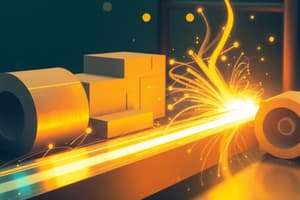Podcast
Questions and Answers
Which of the following best describes the 'Material's Tetrahedron'?
Which of the following best describes the 'Material's Tetrahedron'?
- An illustration showing the interconnected relationships between a material's properties, structure, processing, and performance. (correct)
- A classification system for categorizing materials based on their density, strength, and thermal conductivity.
- A diagram representing the three primary classes of materials: metals, ceramics, and polymers.
- A method for determining a material's suitability for use as a hybrid in composite materials.
Which of the options below exemplifies an intensive property of a material?
Which of the options below exemplifies an intensive property of a material?
- Weight
- Density (correct)
- Volume
- Mass
Which of the following statements accurately distinguishes between elastic and plastic strain?
Which of the following statements accurately distinguishes between elastic and plastic strain?
- Elastic strain occurs at higher stress levels than plastic strain.
- Elastic strain is permanent deformation, while plastic strain is temporary and recovers when stress is removed.
- Elastic and plastic strain both result in permanent deformation, but elastic strain occurs more rapidly.
- Elastic strain recovers when stress is removed, while plastic strain results in permanent deformation. (correct)
How does a material's grain boundaries typically affect its properties?
How does a material's grain boundaries typically affect its properties?
Which of the following characteristics is most indicative of a brittle material?
Which of the following characteristics is most indicative of a brittle material?
What is the primary function of 'secondary treatment' in wastewater treatment plants?
What is the primary function of 'secondary treatment' in wastewater treatment plants?
What role do vacancies play in enabling material properties, particularly at higher temperatures?
What role do vacancies play in enabling material properties, particularly at higher temperatures?
How does upcycling differ from downcycling in the context of sustainable material use?
How does upcycling differ from downcycling in the context of sustainable material use?
Considering the material selection process, what is the purpose of material indices?
Considering the material selection process, what is the purpose of material indices?
What characteristics of activated carbon make it a suitable adsorbent material?
What characteristics of activated carbon make it a suitable adsorbent material?
Flashcards
Material's Tetrahedron
Material's Tetrahedron
Interconnected relationship between material properties, its structure, processing, and its performance.
Material Properties
Material Properties
Material's response to an external stimulus; an inherent feature of a material regardless of size.
Intensive Quantity
Intensive Quantity
Does NOT depend on size (e.g., density, yield stress).
Extensive Quantity
Extensive Quantity
Signup and view all the flashcards
Metals
Metals
Signup and view all the flashcards
Ceramics
Ceramics
Signup and view all the flashcards
Polymers
Polymers
Signup and view all the flashcards
Elastic Strain
Elastic Strain
Signup and view all the flashcards
Plastic Strain
Plastic Strain
Signup and view all the flashcards
Brittle Material
Brittle Material
Signup and view all the flashcards
Study Notes
- Study notes for review
- The notes cover material properties, material selection, failure, fracture, crystal structures, sustainability, and crystalline defects
Material Tetrahedron
- Illustrates the relationship between a material's properties, structure, processing, and performance
Material Properties
- Describes how a material responds to external forces, depends on the material, not size
- Intensive quantity doesn't depend on size
- Extensive quantity depends on size.
Classification of Materials
- General properties include cost and density
- Mechanical properties include strength (yield), stiffness, and toughness (fracture)
- Thermal properties include conductivity, diffusivity, and heat capacity
- Electrical properties include dielectric constant and conductivity
- Magnetic properties include remanence, saturation, and magnetization
- Optical properties include refraction and absorption
- Chemical properties include corrosion resistance, fouling, and surface energy
- Biological properties include biocompatibility and hemocompatibility
Classes of Materials
- Divided into metals, ceramics, polymers, glasses, elastomers, and hybrids
Metals
- Characterized by metallic bonding
- Strong, ductile, and fracture-resistant
- Electrically and thermally conductive
- Includes steels, cast irons, aluminum alloys, and titanium alloys
- Formed by machining, cold working/annealing, and surface treatment
Ceramics
- Bonded by a combination of ionic and covalent bonds
- Generally, inert
- Hard, stiff, and strong, but brittle and prone to fracture
- Insulative to heat and electricity
- Includes alumina, zirconia, silicon, and carbides
Polymers
- Characterized by covalent bonding
- Have immense variety and tuneability
- Composition and structure can be controlled
- Structures comprised of repeating units known as monomers
- Includes polyethylene, polystyrene, polyesters, and epoxies
Glasses
- Types include Silica glass, Soda glass, and Borosilicate glass
Elastomers
- Types include natural rubber, silicones, neoprene, and isoprene
Hybrids
- Include composites, foams, and lattices
Mechanical Properties (LEC 41)
Stress-Strain Behavior
- Materials deform in response to stress
- Strain can be permanent or non-permanent
Elastic Strain
- Is non-permanent and recovers when stress is removed
Plastic Strain
- Is permanent and does not recover when stress is removed
Mechanical Stress
- SI unit is MPa (megapascals)
- Experienced when a tensile force is applied
- Normalizes for the size effect of cross-sectional area
Mechanical Strain
- Results in material extending
- Normalizes the size effect of specimen length
Young's Modulus (E)
- Unit is GPa (gigapascals)
- Ratio of stress to strain when a solid is elastically deformed
- High Young's Modulus corresponds to higher stiffness
Poisson's Ratio
- Applies for uniaxial stress and an isotropic material
Plastic Deformation
- Is non-reversible deformation
- Occurs when applied stress exceeds the yield strength
Yield Strength
- The stress required to produce plastic strain
- Yielding is the onset of plastic deformation
Ultimate Tensile Strength
- Is the maximum stress the material can withstand while being stretched
Elongation to Failure
- Is the strain at which a tensile specimen fails
Ductility
- Refers to how much a material plastically deforms before it fractures
Brittleness
- Is when material experiences minimal plastic deformation
Material Selection (LEC 42)
Material Index
- Combination of material properties that characterize performance
Property Limit
- Sets limits on material properties
Material Selection Process
- Translation of design requirements into material specifications
- Screening of materials that fail to meet specifications
Material Selection - Continued
- Ranking by the ability to meet objectives using material indices
- Search for supporting information for promising candidates
Additional Notes on Material Selection
- Highest MPI = nearest to slope in Ashby chart
- Functional requirement, geometric parameter, and material performance index are important
Material Performance Index
- Elastic modulus, yield strength, and density
Failure and Fracture (LEC 43)
Fracture
- Separation of a body into two or more pieces in response to an imposed stress
- Applied stresses can be tensile, compressive, shear, or torsional
Fracture Modes
- Brittle fracture: crack spreads rapidly with little plastic deformation
- Ductile fracture: extensive plastic deformation in the vicinity of an advancing crack
Stress Concentrations
- Measured fracture strengths for most materials are lower than theory
Ductile Fracture (necking)
- Materials have defects that act as stress concentrators
Brittle Fracture
- No deformation and rapid crack propagation
Fracture Toughness
- Material property that determines whether a material fails in a brittle or ductile manner
Fracture Types
- Brittle fracture when K > KIC and ductile fracture when K < KIC
Ductile to Brittle Transition
- Thermoset retains form when heated and generally brittle
- Thermoplastic can melt under heat; may be brittle or ductile
Crystal Structures (LEC 44)
Arrangement Types
- Crystalline (ordered), amorphous (no order), and mixed (semi-crystalline)
Crystal Structure by Material
- Metals are usually crystalline, ceramics are often crystalline, polymers are never fully crystalline
Unit Cell
- The basic repeating unit of a crystal structure
Simple Cubic Unit Cells
- Composed of 1/8 atoms at each corner
- Coordination number is 6
Body-Centered Cubic (BCC)
- Atoms at all eight corners and one in the center
Face-Centered Cubic (FCC)
- Atoms at all eight corners and one at each face
Hexagonal Close Packed (HCP)
- Atoms at the corners of the top/bottom faces, 2 face atoms, and 3 interior atoms
Polymorphism (Allotropy)
- Ability of materials to exist in multiple crystal structures
Filtration in WWTPs (LEC 45)
Primary Treatment
- Removes physical contamination
Secondary Treatment
- Removes biological contamination
Tertiary Treatment
- Filtration process
Types of Filtration Processes
- Granular filtration, adsorption, and membrane filtration
Adsorbent Materials
- Zeolites, synthetic polymeric adsorbents, and activated carbon
Adsorption – Ion Exchange
- Contaminated water goes in the filtration pipe and NO3 & Cl exchange process
Important Adsorption Factors
- Surface area, pore size, adsorption sites, and accessibility
Membrane Filtration
- Outsite-in filtration for contaminants screened outside and Inside-out for contaminants screened inside.
Sustainability in Engineering (LEC 46)
Ecological Footprints
- Measures the amount of nature's resources consumed
Carbon Footprint
- Total amount of greenhouse gases generated by our actions
Life Cycle Assessment (LEC 47)
- To evaluate potential environmental impacts
Design for Environment
- Reduce, reuse, and recycle
Reduce the mass energy
- Used in the production of technology
Reuse
- Materials and equipment required for production
Recycle
- Waste products produced during manufacturing and operation
Crystalline Defects (LEC 48)
Porosity
- Volume fraction of a solid that is empty
Defects
- Does not always imply a negative effect on properties
Point Defects
- Vacancy is a lattice position that is vacant because the atom is missing
- Interstitial is an atom that occupies a place outside the normal lattice position
Vacancies
- Enable material properties for ionic compounds
Line Defects
- Dislocations are extra, also missing half plane
Planar Defects
- Surface atoms have higher energy than bulk atoms
Planar Defects - Grain Boundaries
- Most solids are polycrystalline and contain many grains separated by transition regions
Properties Enabled by Grain Boundaries
- Grain boundaries influence strength, toughness, and creep rate
Bulk Defects
- Voids, porosity, and cracks
Studying That Suits You
Use AI to generate personalized quizzes and flashcards to suit your learning preferences.





